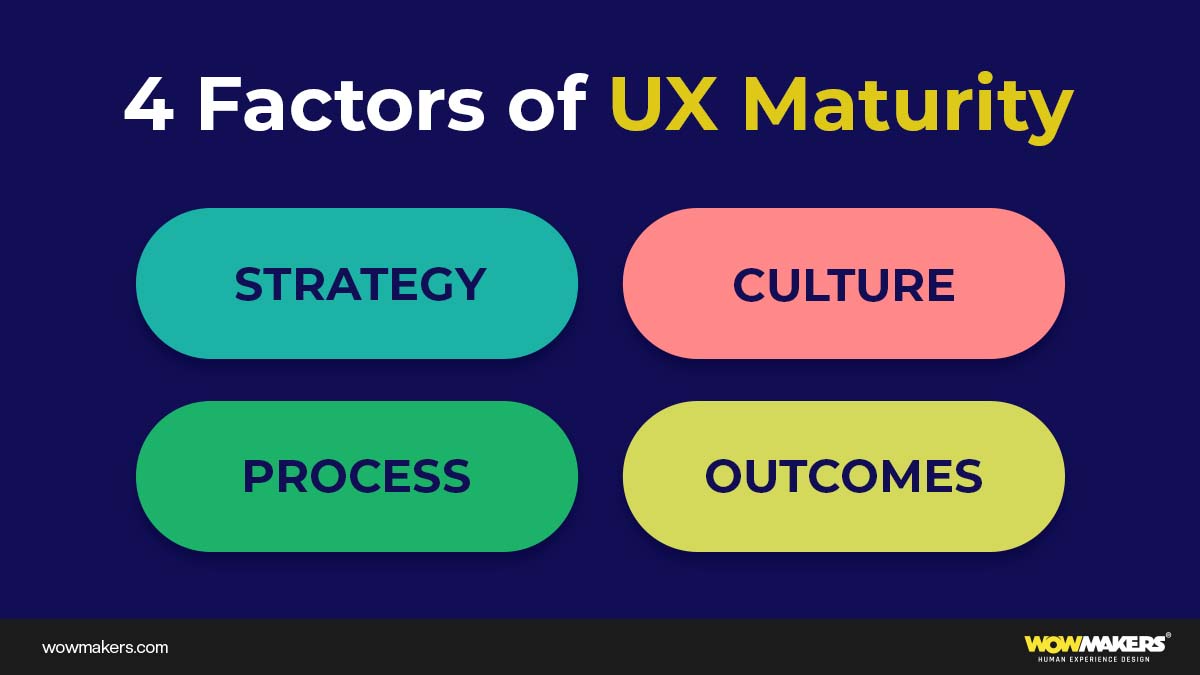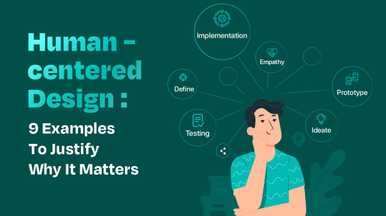What is User Experience (UX) Maturity?
User Experience Maturity (or UX Maturity) measures how well a company designs, builds and delivers experiences to users that meet their needs. It describes a journey from uncommitted to committed UX practice, i.e., from a fundamental understanding of UX principles to advanced UX expertise in the organization.
UX maturity is not a one-time event but a continuing effort to create better UX practices, technologies, and tools.
It involves continually evaluating UX design processes and investing in training and UX-related research.
The concept of user Experience (UX) Maturity is developed by Jakob Nielsen and Don Norman.
It is about assessing the quality of your customer’s experience when interacting with or using your product or service.
Its key idea is to identify areas where companies can improve their UX design to provide a better customer experience.
UX maturity models help companies evaluate how effective their UX strategies are and help them determine where they need to focus more attention to improve the user experience they offer.
These models typically include user research, usability testing, analytics, and customer feedback.
By analyzing these elements, companies can better understand how well they meet customer needs and expectations and determine which areas could benefit from additional investments or improvements.
What is a UX-Maturity Model?
The UX maturity model is a framework for assessing UX-related strengths and weaknesses in an organization.
It helps to evaluate where the business stands in terms of UX and how it can improve its UX maturity by progressing through the six stages.
The UX maturity model gives an organization a holistic view of UX design. This allows teams to make strategic decisions that positively impact UX outcomes.
The Importance of UX Maturity

UX maturity is critical to increasing user engagement, loyalty, and retention.
With UX maturity, companies can create delightful user experiences that drive customer loyalty and increase their bottom line.
- UX maturity is a continuous journey but one with tremendous rewards.
- UX maturity is essential for organizations aiming to implement their UX strategy.
- With a mature UX strategy, developers can create products more quickly, decreasing development time and reducing overall costs associated with building those products.
- UX research helps companies make crucial product decisions aligned with users’ needs and expectations.
- It leads to an efficient product development process, reducing user-related risks.
- Having a high level of UX maturity allows organizations to adapt quickly when changes are needed to keep up with customer demands and ever-evolving trends in the tech industry.
- It helps guarantee a user-centered approach to design, leading to improved products and customer satisfaction.
- UX maturity is essential for organizations looking to stay ahead in the ever-evolving UX landscape.
- UX maturity helps create a culture of user focus, leading to better UX outcomes and increased customer loyalty.
- Helps strengthen the relationship between companies and their customers, reinforcing the company’s brand image as one that values usability and customer feedback when creating new products or services
Levels in UX maturity

Level 1 – Missing or Hostile
The company at this stage is indifferent to the user experience or thinks it does not need it.
User experience is unknown or rarely practiced in these organizations.
This can range from startups to established organizations with legacy workflows that are not user-centric.
At this level, there may be little knowledge about user experience or half-hearted ideas that never result in attempts. In some cases, these organizations might even show hostility towards UX practice.
If you are in this level, we recommend you to check out A Beginner’s Guide to User-Centered Design
Level 2 – Initial Signs
The organization at this stage may show some sense of UX and occasionally participate in user experience activities.
User experience as a strategy is not considered or incorporated into product design and development. UX is given the lowest priority.
It is still not considered an official discipline, and no dedicated user experience role, process, or budget exists.
In most companies, user experience-centric activities happen only across one or two departments at this stage. The organization is still oblivious and at level 1 of UX maturity.
Level 3 – Scattered
A company at this stage becomes aware of what user experience is and how important it is in its product or service.
The management might decide to hire a UX specialist or a UX agency. But they still don’t perceive the significance of having a dedicated UX team or considering UX in decision-making.
At this stage, the company puts minimal effort into UX. It is inconsistent, and UX is still not identified as an organizational policy; instead, it is based on individual managers’ initiative.
There is no defined system or extensive user experience process. Some stakeholders may defend UX and its importance.
But UX is still the first to be compromised when trade-offs are necessary, as UX is still not prioritized as a primary strategy.
It is common for large companies to get stuck in the third level of UX maturity, especially in traditional businesses like finance and healthcare.
Level 4 – Recognised
By this stage, the company recognizes the role of UX in its success.
Now they have a dedicated UX team and a budget allocated for it.
At this stage, the idea of UX spreads across all the departments, and leadership considers UX in decision-making.
User research is conducted throughout the design and development phases of the product’s lifecycle. Departments like marketing, sales, customer service, etc., also get involved in the UX process.
The dedicated budget used for UX demands better explanations from the top management. The team should be able to defend the UX process with KPIs and data rather than just intuition and experience.
Level 5 – As a Strategy
This level, which every organization aims to reach, makes sure UX is interwoven in every process they undertake.
This will eventually help them achieve their business goals.
UX is now part of the strategy and influences all business aspects- development, sales, marketing, operations, and customer service.
Most of the teams in the organization perform activities related to user experience efficiently. The company now invests in bringing about innovations in the field of UX methods and processes.
KPIs of such organizations focus on UX and are even driven by UX-related activities.
Level 6 – UX Centric
UX is now part of the culture. The entire organization- from top management to interns- is fully enlightened about user-centered design.
The organization now considers user experience in every aspect of its operation, ranging from the highest level of strategy to minor product decisions.
They even try to bring change and innovation into the industry standards.
These companies use user research to drive new investments and target new markets.
An organization at this stage has achieved the ultimate user experience maturity but struggles to maintain the position for a long time.
Hurdles like conflicting goals or internal politics etc., emerge, resulting in the decline of UX maturity.
Some organizations at this level tend to lose focus on their user-centric approach due to scaling, acquisitions, mergers, changes in leadership, and culture shifts and eventually slip back down to lower UX-maturity levels over time.
UX Maturity of an Organization
One of the critical challenges facing UX design agencies and UX professionals is educating and convincing the stakeholders of an organization about the critical role user experience design plays in the organization’s success.
Be it a global brand, Fortune 100 enterprise, government agency, unicorn startup, non-profit or mom-and-pop store, user experience is the fundamental factor that decides success.
From retaining existing customers to attracting new users, reducing churn rates to increasing conversion rates, and improving reputation and brand loyalty- UX plays a critical role in your organization’s business, even if you are aware.
So it is essential to understand where your organization stands regarding UX adoption. UX maturity level measures an organization’s desire and ability to consider and incorporate UX design.
It measures the awareness and attitude of the stakeholders, the quality of research and design, resources and tools, and the organization’s willingness to support and strengthen UX now and in the future through its leadership, workforce, and culture.
Integrating UX into the product development process as early as possible is the most effective way. in short, early and continuous commitment to UX
This can be done by involving UX professionals in the early stages of planning and creativity, ensuring that user needs and goals are considered from the outset.
Even if a company doesn’t have a dedicated UX team, involving stakeholders with a user-centered mindset, such as customer support or sales teams, can help identify user needs and challenges.
However, the biggest challenge is the organization itself. They often do not place a high value on UX design.
As a result of a lack of dedication, UX professionals were often left out of the development of new products, had no say in the formulation of product requirements, and were slow to carry out crucial UX research activities that could have informed crucial design choices.
Organizational Maturity vs. Team Maturity
Organization UX maturity looks at the UX maturity of the whole organization, including all product teams and divisions within it.
It considers how UX processes are integrated across departments and how UX efforts are supported organization-wide.
Team UX maturity looks at how well each product team can manage UX processes, use UX tools and techniques, and collaborate with other teams.
It can be measured by looking at the quality of UX research and design outputs or the level of UX engagement within a team. It will vary depending on each team’s goals, resources, and culture.
| Aspect | Organizational Maturity | Team Maturity |
| Scope | Entire organization | Specific team |
| Focus | System-wide efficiency | Team performance |
| Level of analysis | Macro-level | Micro-level |
| Leadership involvement | High-level strategic planning and decision making | Day-to-day supervision and guidance |
| Impact | Affects all teams | Affects specific teams only |
| Timeline | Long-term | Short-term |
| Resources | Large-scale investment | Small-scale investment |
| Implementation | Complex and gradual | Focused and rapid |
| Metrics | Organizational goals | Team goals |
The 4 Factors of UX Maturity

Strategy
Developing a long-term plan for the organization’s user experience initiatives, including tangible goals and objectives.
This includes defining the UX team’s roles and responsibilities, identifying key stakeholders and resources needed to achieve success, and outlining any processes needed to execute the plan effectively.
Culture
Establishing a culture that puts user experience considerations at its core, encouraging open communication between departments, giving stakeholders an understanding of how user experience works and incentivizing cross-team collaboration to ensure alignment with business objectives.
Process
Designing robust processes that streamline data collection and analysis; aligning organizational standards with UX best practices; establishing criteria for measuring success; ensuring consistency across product lifecycles; creating shared experiments for continuous learning; and elevating the role of design in decision making.
Outcomes
Capturing meaningful outcomes from UX initiatives, such as increased engagement or improved customer satisfaction scores. To do this, organizations must continually monitor performance metrics to gauge the effectiveness of their strategies and refine them as necessary.
How to Assess the UX Maturity of Your Company?
UX Maturity in an Organization measures an organization’s ability to effectively and efficiently incorporate user experience (UX) practices into its product and service design processes.
It encompasses the full spectrum of UX-related activities, including design thinking, usability testing, accessibility guidelines, customer feedback, user research, and more.
It is essential not only to assess where a company stands in terms of UX maturity but also to identify actionable steps that can be taken to improve it.
To this end, assessments often involve developing a roadmap that outlines short-term improvements and key milestones toward achieving more advanced UX capabilities over time.
As organizations become more mature in UX, they develop more profound insights into customer needs and desires, leading to better designs that are highly usable, accessible, reliable, and delightful.
Organizations at different stages of UX maturity may have different approaches to achieving these goals.
Companies with mature UX practices embed a user-centric approach throughout their product development life cycle and all touchpoints between the company and its customers.
This includes
- Rigorous usability testing of prototypes with actual users.
- Leveraging customer feedback from surveys and interviews
- Using toolkits, guidelines, and templates built around industry standards such as ISO 9241-210 & 210X-251. This help ensures consistent quality across all products or services being developed within an organization.
- Incorporating accessibility guidelines into all phases of product development; maintaining a comprehensive understanding of target users.
- Developing an organizational culture that values user experience; investing in skills training for designers and developers.
- Elevating the value placed on usability engineering within the organization, setting visibility metrics for evaluating success.
- Creating methods for measuring ROI from UX efforts.
By placing importance on UX as part of their process, companies can create more effective products tailored to meet customer needs while meeting business objectives.
Moreover, consistently using best practices helps ensure higher quality products while reducing costly errors by discovering them early in the design process.
Effective UX Maturity Models
- Jonathan Earthy’s Usability Maturity Scale
- Jakob Neilsen’s Corporate Usability Maturity
- Forrester’s Experience-Based Differentiation
- The Journey to a Customer-Centric Business, by Infosys
- Indicators of UX Maturity, by Macadamian
- Design Management Institute (DMI)’s Design Maturity Matrix
- Danish Design Centre (DDC)’s Design Ladder
- UX Maturity level model by Chapman and Plewes’
Relationship Between UX Maturity and UX Research
The relationship between UX Maturity and UX Research is a symbiotic one.
As UX maturity increases, the need for research and understanding user needs and preferences also increases.
Research helps decide what features and design elements should be developed or modified to create a satisfying user experience.
The more mature the UX process, the more sophisticated the data-gathering techniques used to measure user satisfaction, enabling design teams to make better decisions about their products.
UX research can include customer interviews, surveys, focus groups, usability tests, and analytics data.
By utilizing these methods during each product development phase, designers can better understand how users interact with their products or services.
This promotes higher-quality design and provides feedback on any areas of improvement, which can then be addressed in subsequent iterations.
By combining experienced UX professionals such as user researchers with an understanding of user needs, teams can create products tailored to their users’ wants and needs.
This means that a higher degree of UX maturity allows teams to produce products that have been carefully designed based on feedback from real-world users – leading to greater customer satisfaction.
Furthermore, with deeper insights gained from UX research, teams can develop better solutions for complex problems, which would not have been possible without this data-driven approach.
Conclusion
It’s essential to understand the organization’s UX maturity. This helps identify its strengths and weaknesses, defending and rewarding what has been done well.
This understanding will also assist in identifying and improving areas that are not up to the standards.
The organization should invest continuous efforts to advance to the next level of UX maturity. Going up the ladder of UX maturity is a slow process, and there is no possibility of skipping or leaping to higher levels.
Every company, even those with high levels of UX maturity, should involve themselves in self-assessments to understand their level of UX maturity to make improvements and consistently provide the best experience to its users.






